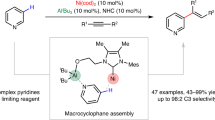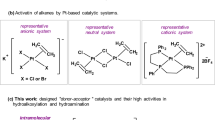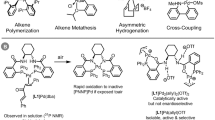Abstract
Developing earth-abundant, non-platinum metal catalysts for high-value chemical transformations is a critical challenge to contemporary chemical synthesis. Dearomatization of pyridine derivatives is an important transformation to access a wide range of valuable nitrogenous natural products, pharmaceuticals and materials. Here, we report an efficient 1,2-regioselective organolanthanide-catalysed pyridine dearomatization process using pinacolborane, which is compatible with a broad range of pyridines and functional groups and employs equimolar reagent stoichiometry. Regarding the mechanism, derivation of the rate law from NMR spectroscopic and kinetic measurements suggests first order in catalyst concentration, fractional order in pyridine concentration and inverse first order in pinacolborane concentration, with C=N insertion into the La–H bond as turnover-determining. An energetic span analysis affords a more detailed understanding of experimental activity trends and the unusual kinetic behaviour, and proposes the catalyst ‘resting’ state and potential deactivation pathways.
This is a preview of subscription content, access via your institution
Access options
Subscribe to this journal
Receive 12 print issues and online access
$259.00 per year
only $21.58 per issue
Buy this article
- Purchase on Springer Link
- Instant access to full article PDF
Prices may be subject to local taxes which are calculated during checkout





Similar content being viewed by others
References
Bullock, R. M. Catalysis Without Precious Metals (Wiley, 2010).
Bullock, R. M. Abundant metals give precious hydrogenation performance. Science 342, 1054–1055 (2013).
National Research Council The Role of the Chemical Sciences in Finding Alternatives to Critical Resources: A Workshop Summary (The National Academies Press, 2012).
Eijsbouts, S., Anderson, G. H., Bergwerff, J. A. & Jacobi, S. Economic and technical impacts of replacing Co and Ni promotion in hydrotreating catalysts. Appl. Catal. A 458, 169–182 (2013).
Wender, P. et al. What lies ahead. Nature 469, 23–25 (2011).
Harrison, K. N. & Marks, T. J. Organolanthanide-catalyzed hydroboration of olefins. J. Am. Chem. Soc. 114, 9220–9221 (1992).
Hong, S. & Marks, T. J. Organolanthanide-catalyzed hydroamination. Acc. Chem. Res. 37, 673–686 (2004).
Fu, P-F., Brard, L., Li, Y. & Marks, T. J. Regioselection and enantioselection in organolanthanide-catalyzed olefin hydrosilylation. A kinetic and mechanistic study. J. Am. Chem. Soc. 117, 7157–7168 (1995).
Obora, Y., Ohta, T., Stern, C. L. & Marks, T. J. Organolanthanide-catalyzed imine hydrogenation. Scope, selectivity, mechanistic observations, and unusual byproducts. J. Am. Chem. Soc. 119, 3745–3755 (1997).
Pape, A. R., Kaliappan, K. P. & Kündig, E. P. Transition-metal-mediated dearomatization reactions. Chem. Rev. 100, 2917–2940 (2000).
Roche, S. P. & Porco, J. A. Dearomatization strategies in the synthesis of complex natural products. Angew. Chem. Int. Ed. 50, 4068–4093 (2011).
Stout, D. M. & Meyers, A. I. Recent advances in the chemistry of dihydropyridines. Chem. Rev. 82, 223–243 (1982).
Edraki, N., Mehdipour, A. R., Khoshneviszadeh, M. & Miri, R. Dihydropyridines: evaluation of their current and future pharmacological applications. Drug Discov. Today 14, 1058–1066 (2009).
Lavilla, R. Recent developments in the chemistry of dihydropyridines. J. Chem. Soc. Perkin Trans. 1, 1141–1156 (2002).
Wender, P. A., Schaus, J. M. & White, A. W. General methodology for cis-hydroisoquinoline synthesis: synthesis of reserpine. J. Am. Chem. Soc. 102, 6157–6159 (1980).
Mizoguchi, H., Oikawa, H. & Oguri, H. Biogenetically inspired synthesis and skeletal diversification of indole alkaloids. Nature Chem. 6, 57–64 (2014).
Duttwyler, S. et al. A. Regio- and stereoselective 1,2-dihydropyridine alkylation/addition sequence for the synthesis of piperidines with quaternary centers. Angew. Chem. Int. Ed. 53, 3877–3880 (2014).
Satoh, N., Akiba, T., Yokoshima, S. & Fukuyama, T. A practical synthesis of (–)-oseltamivir. Angew. Chem. Int. Ed. 46, 5734–5736 (2007).
Bull, J. A., Mousseau, J. J., Pelletier, G. & Charette, A. B. Synthesis of pyridine and dihydropyridine derivatives by regio- and stereoselective addition to N-activated pyridines. Chem. Rev. 112, 2642–2713 (2012).
Arrowsmith, M., Hill, M. S., Hadlington, T., Kociok-Köhn, G. & Weetman, C. Magnesium-catalyzed hydroboration of pyridines. Organometallics 30, 5556–5559 (2011).
Oshima, K., Ohmura, T. & Suginome, M. Regioselective synthesis of 1,2-dihydropyridines by rhodium-catalyzed hydroboration of pyridines. J. Am. Chem. Soc. 134, 3699–3702 (2012).
Osakada, K. 1,4-Hydrosilylation of pyridine by ruthenium catalyst: a new reaction and mechanism. Angew. Chem. Int. Ed. 50, 3845–3846 (2011).
Hao, L. et al. Homogeneous catalytic hydrosilylation of pyridines. Angew. Chem. Int. Ed. 37, 3126–3129 (1998).
Gutsulyak, D. V., van der Est, A. & Nikonov, G. I. Facile catalytic hydrosilylation of pyridines. Angew. Chem. Int. Ed. 50, 1384–1387 (2011).
Lee, S-H., Gutsulyak, D. V. & Nikonov, G. I. Chemo- and regioselective catalytic reduction of N-heterocycles by silane. Organometallics 32, 4457–4464 (2013).
Jeske, G. et al. Highly reactive organolanthanides. Systematic routes to and olefin chemistry of early and late bis(pentamethylcyclopentadienyl) 4f hydrocarbyl and hydride complexes. J. Am. Chem. Soc. 107, 8091–8103 (1985).
Weiss, C. J. & Marks, T. J. Organo-f-element catalysts for efficient and highly selective hydroalkoxylation and hydrothiolation. Dalton Trans. 39, 6576–6588 (2010).
Humphries, M. Rare Earth Elements: The Global Supply Chain (Congressional Research Service, 2013).
Gountchev, T. I. & Tilley, T. D. Yttrium complexes of the chelating, C2-symmetric, bis(silylamido)biphenyl ligand [DADMB]2− (={[6,6′-Me2-(C6H3)2](2,2′-NSiMe2tBu)2}2−). Organometallics 18, 2896–2905 (1999).
Reznichenko, A. L. & Hultzsch, K. C. Early transition metal (group 3–5, lanthanides and actinides) and main group metal (group 1, 2, and 13) catalyzed hydroamination. Top. Organomet. Chem. 43, 51–114 (2013).
Oshima, K., Ohmura, T. & Suginome, M. Dearomatizing conversion of pyrazines to 1,4-dihydropyrazine derivatives via transition-metal-free diboration, silaboration, and hydroboration. Chem. Commun. 48, 8571–8573 (2012).
Ringelberg, S. N. Bond Activation and Catalysis with Organolanthanides Ch. 5, Dissertation, Univ. Library Groningen (2001).
Barnea, E., Andrea, T., Kapon, M. & Eisen, M. S. Formation of inclusion organoactinide complexes with boron-containing macrocycles. J. Am. Chem. Soc. 126, 5066–5067 (2004).
Kratsch, J. et al. Chiral rare earth borohydride complexes supported by amidinate ligands: synthesis, structure, and catalytic activity in the ring-opening polymerization of rac-lactide. Organometallics 32, 1230–1238 (2013).
Evans, W. J., Perotti, J. M. & Ziller, J. W. Trialkylboron/lanthanide metallocene hydride chemistry: polydentate bridging of (HBEt3)− to lanthanum. Inorg. Chem. 44, 5820–5825 (2005).
Schaedle, C., Meermann, C., Törnroos, K. W. & Anwander, R. Rare-earth metal phenyl(trimethylsilyl)amide complexes. Eur. J. Inorg. Chem. 2841–2852 (2010).
Männig, D. & Nöth, H. Metal tetrahydridoborates and tetrahydridoboratometallates: XIII. New and convenient syntheses of dicyclopentadienylzirconium tetrahydridoborate. J. Organomet. Chem. 275, 169–171 (1984).
Sevov, C. S., Zhou, J. & Hartwig, J. F. Iridium-catalyzed intermolecular hydroamination of unactivated aliphatic alkenes with amides and sulfonamides. J. Am. Chem. Soc. 134, 11960–11963 (2012).
Muhoro, C. N., He, X. & Hartwig, J. F. Titanocene borane σ− complexes. J. Am. Chem. Soc. 121, 5033–5046 (1999).
Amin, S. B. & Marks, T. J. Versatile pathways for in situ polyolefin functionalization with heteroatoms: catalytic chain transfer. Angew. Chem. Int. Ed. 47, 2006–2025 (2008).
Kozuch, S. A refinement of everyday thinking: the energetic span model for kinetic assessment of catalytic cycles. WIREs Comput. Mol. Sci. 2, 795–815 (2012).
Kozuch, S. & Shaik. S. How to conceptualize catalytic cycles? The energetic span model. Acc. Chem. Res. 44, 101–110 (2011).
Wobser, S. D., Stephenson, C. J., Delferro, M. & Marks, T. J. Carbostannolysis mediated by bis(pentamethylcyclopentadienyl)lanthanide catalysts. Utility in accessing organotin synthons. Organometallics 32, 1317–1327 (2013).
Perrin, L., Werkema, E. L., Eisenstein, O. & Andersen, R. A. Two [1,2,4-(Me3C)3C5H2]2CeH molecules are involved in hydrogenation of pyridine to piperidine as shown by experiments and computations. Inorg. Chem. 53, 6361–6373 (2014).
McSkimming, A. & Colbran, S. B. The coordination chemistry of organo-hydride donors: new prospects for efficient multi-electron reduction. Chem. Soc. Rev. 42, 5439–5488 (2013).
Diaconescu, P. L. Reactions of aromatic N-heterocycles with d0fn-metal alkyl complexes supported by chelating diamide ligands. Acc. Chem. Res. 43, 1352–1363 (2010).
Jantunen, K. C., Scott, B. L., Hay, P. J., Gordon, J. C. & Kiplinger, J. L. Dearomatization and functionalization of terpyridine by lutetium(III) alkyl complexes. J. Am. Chem. Soc. 128, 6322–6323 (2006).
Edelmann, F. T. Lanthanides and actinides: annual survey of their organometallic chemistry covering the year 2011. Coord. Chem. Rev. 261, 73–155 (2014).
Minasian, S. G., Krinsky, J. L. & Arnold, J. Evaluating f-element bonding from structure and thermodynamics. Chem. Eur. J. 17, 12234–12245 (2011).
Glassey, W. V. & Hoffman, R. A comparative study of Hamilton and overlap population methods for the analysis of chemical bonding. J. Chem. Phys. 113, 1698–1704 (2000).
Acknowledgements
The authors acknowledge financial support from the National Science Foundation (NSF, grant no. CHE-1213235). A.S.D. is supported by the Camille and Henry Dreyfus Postdoctoral Program in Environmental Chemistry. V.L.W. thanks the NSF for a Graduate Research Fellowship. NMR instrumentation purchases at IMSERC at Northwestern University were supported by the NSF (CHE-1048773). Computational resources supporting this work were provided by the Northwestern University Quest High Performance Computing cluster (M.D.) and CINECA Award HP10CPZK0T 2013 (A.M.). The authors thank S. Kozuch (University of North Texas) for providing the AUTOF program and valuable suggestions and R.J. Thomson (Northwestern University) for helpful discussions.
Author information
Authors and Affiliations
Contributions
A.S.D., M.D. and T.J.M. conceived and designed the experiments. V.L.W., A.S.D. and M.D. performed the experiments and analysed the data. A.M. performed DFT calculations. A.S.D., A.M., M.D. and T.J.M. co-wrote the manuscript. All authors contributed to revising the manuscript.
Corresponding authors
Ethics declarations
Competing interests
The authors declare no competing financial interests.
Supplementary information
Supplementary information
Supplementary information (PDF 6879 kb)
Supplementary information
Crystallographic data for compound 4 (CIF 2243 kb)
Rights and permissions
About this article
Cite this article
Dudnik, A., Weidner, V., Motta, A. et al. Atom-efficient regioselective 1,2-dearomatization of functionalized pyridines by an earth-abundant organolanthanide catalyst. Nature Chem 6, 1100–1107 (2014). https://doi.org/10.1038/nchem.2087
Received:
Accepted:
Published:
Issue Date:
DOI: https://doi.org/10.1038/nchem.2087
This article is cited by
-
Thiocyanate-induced N-activation and nucleophilic 1,2-dearomatization of pyridinedicarbonyl dichloride: a synthetic route to a novel 1,2-dihydropyridine-based heterocyclic compound
Journal of the Iranian Chemical Society (2023)
-
Controlled partial transfer hydrogenation of quinolines by cobalt-amido cooperative catalysis
Nature Communications (2020)
-
Polynuclear lanthanide–diketonato clusters for the catalytic hydroboration of carboxamides and esters
Nature Catalysis (2020)
-
Synthesis of 6-R-isoxazolo[4,3-b]pyridines and their reactions with C-nucleophiles
Russian Chemical Bulletin (2020)
-
Catalytic dearomative hydroboration of heteroaromatic compounds
Journal of Chemical Sciences (2019)



